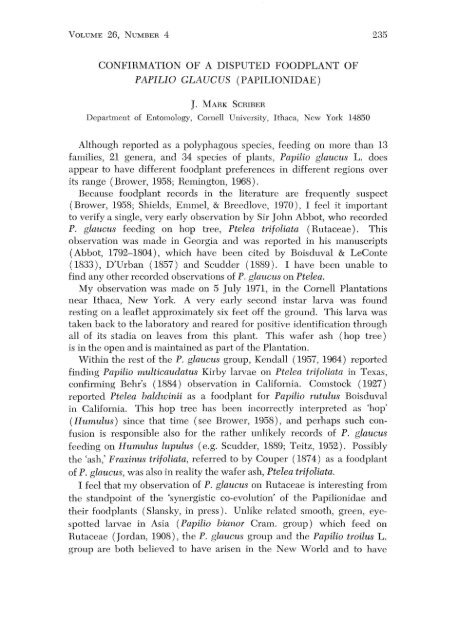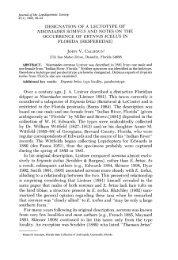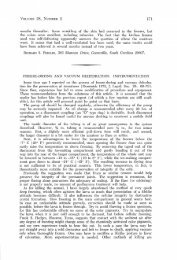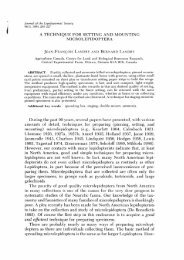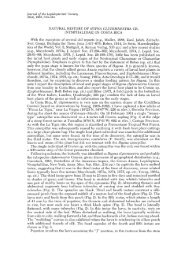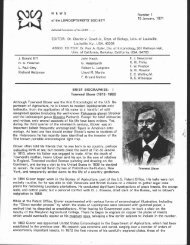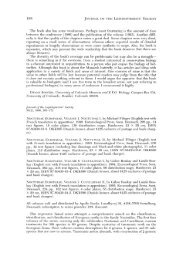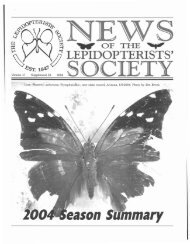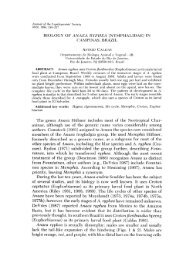CONFIRMATION OF A DISPUTED FOODPLANT ... - Yale University
CONFIRMATION OF A DISPUTED FOODPLANT ... - Yale University
CONFIRMATION OF A DISPUTED FOODPLANT ... - Yale University
Create successful ePaper yourself
Turn your PDF publications into a flip-book with our unique Google optimized e-Paper software.
VOLUME 26, NUMBER 4<br />
235<br />
<strong>CONFIRMATION</strong> <strong>OF</strong> A <strong>DISPUTED</strong> <strong>FOODPLANT</strong> <strong>OF</strong><br />
PAPILlO GLAUCUS (PAPILIONIDAE)<br />
J. MARK SCRIBER<br />
Department of Entomology, Cornell <strong>University</strong>, Ithaca, New York 14850<br />
Although reported as a polyphagous species, feeding on more than 13<br />
families, 21 genera, and 34 species of plants, Papilio glaucus L. does<br />
appcar to have different foodplant preferences in different regions over<br />
its range (Brower, 1958; Remington, 1968).<br />
Because foodplant records in the literature are frequently suspect<br />
(Brower, 1958; Shields, Emmel, & Breedlove, 1970 ), I feel it important<br />
to verify a single, very early observation by Sir John Abbot, who recorded<br />
P. glaucus feeding on hop tree, Pte lea trifoliata ( Rutaceae ) . This<br />
observation was made in Georgia and was reported in his manuscripts<br />
(Abbot, 1792-1804), which have been cited by Boisduval & LeConte<br />
(1833), D'Urban (1857) and Scudder (1889 ). I have been unable to<br />
find any other recorded observations of P. glaucus on Ptelea.<br />
My observation was made on 5 July 1971, in the Cornell Plantations<br />
near Ithaca, New York. A very early second instal' larva was found<br />
resting on a leaflet approximately six feet off the ground. This larva was<br />
taken back to the laboratory and reared for positive identification through<br />
all of its stadia on leaves from this plant. This wafer ash (hop tree)<br />
is in thc open and is maintained as part of the Plantation.<br />
Within the rest of the P. glaucus group, Kendall (1957, 1964) reported<br />
finding Papilio multicaudatus Kirby larvae on Ptelea trifoliata in Texas,<br />
confirming 13ehr's (1884 ) observation in California. Comstock (1927)<br />
reported Pte lea baldwinii as a foodplant for Papilio rutulus Boisduval<br />
in California. This hop tree has been incorrectly interpreted as 'hop'<br />
(Humulus) since that time (see Brower, 1958), and perhaps such confusion<br />
is responsible also for the rather unlikely records of P. glaucus<br />
feeding on Humulus lupulus (e.g. Scudder, 1889; Teitz, 1952). Possibly<br />
the 'ash,' Fraxinus trifoliata, referred to by Couper (1874) as a foodplant<br />
of P. glaucus, was also in reality the wafer ash, Pte lea trifoliata.<br />
I feel that my observation of P. glaucus on Rutaceae is interesting from<br />
the standpoint of the 'synergistic co-evolution' of the Papilionidae and<br />
their foodplants (Slansky, in press). Unlike related smooth, green, eycspotted<br />
larvae in Asia (Papilio bianor Cram. group) which feed on<br />
Rutaceae (Jordan, 1908), the P. glaucus group and the Papilio troilus L.<br />
group are both believed to have arisen in the New World and to have
236 JOURNAL <strong>OF</strong> THE LEPIDOPTERISTS' SOCIETY<br />
fed originally on Lauraceac and Magnoliaceae before expanding their<br />
foodplant diets (Forbes, 1932, 19,58; Munroe, 1960).<br />
Having both the essential oils of the Umbelliferae and the alkaloids of<br />
the Aristolochiaceae and Magnoliales (including Magnoliaceae, Lauraceae,<br />
and Annonaceae), the Rutaceae seem to have played a key role in much<br />
of the co-evolution of the Papilionidae and their foodplants (Dethier,<br />
1941; Ehrlich & Raven, 196,5). Whether or not this P. glaucus-Rutaceae<br />
interaction is some relic from the phylogenetic past of P. glaucus, or a<br />
secondary consequence of its polyphagous habit, is unknown.<br />
LITERATURE CITED<br />
AnnOT, J. 1792-1804. Drawings of the Insects of Georgia. 17 vols. Library of<br />
the British Museum. Also Boston Society of Natural History: Oemler and Gray<br />
Collections of Harvard <strong>University</strong> Library.<br />
BEHR, H. H. 1884. Biological synopses of California Lcpidoptera. Bull. Calif. Acad.<br />
Sci. 1: 63-65.<br />
BOISDUVAL, J. A. & M. J, LECONTE. 1833. Histoire generale et iconographie des<br />
Lepidopteres des Chenilles d e I'Amerique septentrionale. Librarie Encyclopedique<br />
de Roret. Paris. 228 p.<br />
BROWEll, L. P. 1958. Larval foodplant specificity in hutterflies of the P. glallclIs<br />
grollp. Lepid. News 12: 103-114.<br />
COMSTOCK, J. A. 1927. Butterflies of California. Comstock, Los Angeles. :334 p.<br />
CoUPER, W. 1874. A dissertation on northern btl'tterflies. Can. EntomoJ. 6: 91-96.<br />
DETHIER, V. G. 1941. Chemical factors determining the choice of foodplants by<br />
Papilio larvae. Amer. Nat. 75: 61-73.<br />
D'URBAN, W. S. M. 1857. On the order Lepidoptera, with the description 0.£ two<br />
species of Canadian butterflies. Can. Nat. & Geo!. 2: 223-236.<br />
EHRLICH, P. R. & P. H. RAVEN. 1965. Butterflies and plants: 'l study in co-evolution.<br />
Evolution 18: 586-608.<br />
FORBES, W. T. M. 1932. How old are the Lepidoptera? Amer. Nat. 98: 452-460.<br />
---. 1958. C'lterpillars as botanists. Proc. 10th Int. Congo Entomo!. 1: 313-317.<br />
JORDAN, K. 1908. The Indo-Australian Hhopalocera, in A. Seitz, Macrolepidoptera<br />
of the World. Vol. 9. Stuttgart.<br />
KENDALL, R. O. 1957. New foodplants in Texas for Papilio mtllticaudatus. Lepid.<br />
News 11 : 224.<br />
---. 1964. Larval foodplants of twenty-six species of Rhopalocem (Papilionidae)<br />
from Texas. J. Lepid. Soc. 18: 129-157.<br />
MUNHOE, E. 1960. The generic classification of the Papilionidae. Can. Entomol.,<br />
Suppl. 17. 51 p.<br />
REMINGTON, C. L. 1968.<br />
Suture zones of hybrid interaction between recently<br />
joined biotas, in 1'. Dobzhansky, ed., Evolutionary Biology 2: 321-428.<br />
SCUDDER, S. H. 1889. The Butterflies 'Of the Eastern U. S. and Canada. 3 vols.<br />
Pub!. by the author. Cambridge, Mass.<br />
SHIELDS, 0., J. M. EMMEL & D. E. BHEEDLOVE. 1970. Butterfly larval foodplant<br />
records and a procedure for reporting foodplants. J. Hes. Lepid. 8: 20--36.<br />
SLANSKY, F. 1973. Latitudinal gradients in species diversity of the New World<br />
swallowtail butterHies (Papilionidae). J. Res. Lepid. (in press).<br />
TIETZ, H. YI, 1952. The Lepidoptera of Pennsylvania, a Manual. Pennsylvania<br />
State College, Pa. 194 p.


